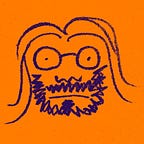Computers beyond calculators
In the early history of the computer industry, computers didn’t really do all that much outside of computations. The name “computer” is actually appropriated from the name of a profession that the devices would eventually replace. Before the 20th century, computers were people (mostly women) who sat at desks with paper and pen, and just crunched numbers all day/night/week/month/year/life. As somebody who struggled with math in primary school, that sounds like a hell nested within a nightmare.
Tabulating and calculating machines were tailor-made to doing these repetitive and mentally taxing tasks, and for 50 years that was all anybody could really think to do with them. Around the mid-century science fiction writers started to hypothesize that computers could be used to make predictions or other more abstract functions. Stories (and some early experimentations) of artificial intelligence started appearing. In the 1940s, Issac Asimov introduced the Three Laws of Robotics, in the 50s UNIVAC correctly predicts the 1952 US Presidential election (and the press at first refused to believe it) and Alan Turing coins the “Imitation Game” and theorizes a future where computers can think like humans.
Computer scientists developed electromechanical ‘robots’ and other devices to experiment with this new branch of science. Some of the software made during this time were simulators and games to test their early forays into AI. The earliest of these was a purpose-built machine called Bertie the Brain, which was a giant Tic-Tac-Toe game, in 1950. Bertie was a bespoke machine designed to play against a human opponent in 3 levels of difficulty, and while it definitely deserves recognition as one of the earliest computer games two years later another Tic-tac-toe game, OXO, would be released that was purely software-based and could be loaded onto the Cambridge University computer mainframe called the EDSAC. OXO was a breakthrough in the brand new industry of computer games.
In 1961, the first video game that was designed to be copied and played on multiple devices was called Spacewar! The game consisted of two spaceships engaged in a dogfight, with limited weaponry and fuel. Ships had to avoid each other as well as other space objects which will cause the ship to explode on collision. It was created by computer science students at MIT for recreation, but it also served as a program that could test the capabilities of the MIT mainframe computers. Spacewar! would later serve as the model for arcade game Asteroids.
Tennis for Two, also served as a proof of concept that would influence later development. It was one of the first computer games made purely for entertainment, rather than as a research tool. The program simulated a tennis court from the point of view of a spectator. Users controlled the angle of shots with connected controllers, and the game calculated trajectory and collisions with the net. In 1958 Tennis for Two was created as an exhibit for visitors to interact with at the Brookhaven National Laboratory and was never meant for wide distribution, but 14 years later a game built on the tennis concept and created the new commercial industry of computer gaming.
Pong was the first commercially successful computer game. Atari had taken ideas played with over the preceding decade and published the software alongside mass producing the machines that ran it. By installing the arcade cabinets in bars, it gave regular people their very first experiences interacting with computers (whether they realized it or not). It was the first time the public really saw the potential of these machines that had some so far from their calculator beginnings. It is said that after a few weeks technicians had been called out to troubleshoot the Pong cabinets because of loads of errors. The technicians had discovered that the errors were being caused by the coin receptacles overflowing with quarters and tripping the sensors.
PC games, and other recreational software is now just a regular part of life that most of us totally take for granted. As a little kid in the 90s I first learned how to design graphics and edit short films using our home computer. Just a decade prior that wasn’t even a thing people had considered as a possibility. In the 70 years we’ve gone since Bertie the Brain was built, we are now living in a world where you cannot go anywhere without computerized entertainment.
In 1950, somebody made their calculator play Tic Tac Toe. In 2020, we make ours play DOOM.
